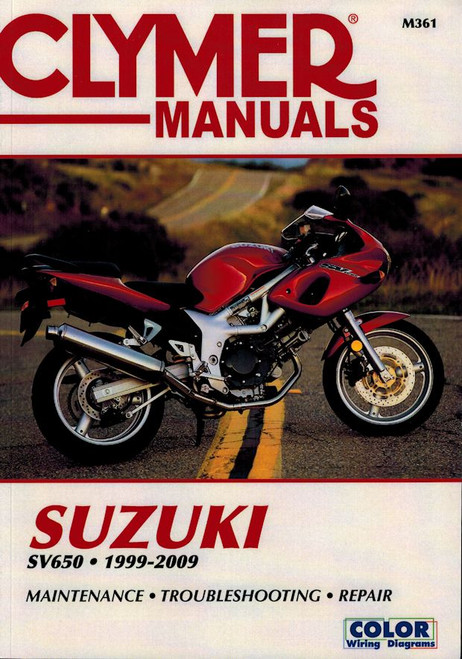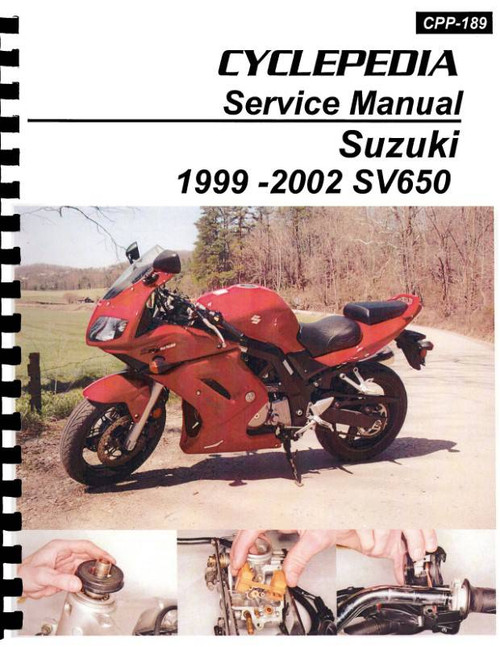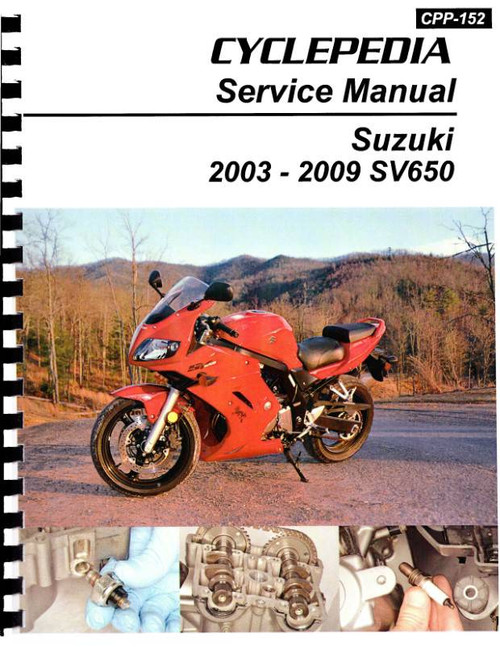The 1999-2008 Suzuki SV650 sportbike DIY repair manual by Haynes covers:
Book Excerpt: 1999-2008 Suzuki SV650 Sportbike Repair Manual ENGINE, CLUTCH AND TRANSMISSION
BRAKES, WHEELS AND TIRES
Subject: 1999, 2000, 2001, 2002, 2003, 2004, 2005, 2006, 2007, 2008 Suzuki SV650, SV650S, SV650A/SA, SV650 Sport service, maintenance, repair. ISBN-10: 1844257673 | ISBN-13: 9781844257676 | Haynes 3912
- Suzuki SV650, 1999-2008
- Suzuki SV650S, 1999-2008
- Suzuki SV650A/SA, 2007-2008
- Suzuki SV650 Sport, 2008
Book Excerpt: 1999-2008 Suzuki SV650 Sportbike Repair Manual ENGINE, CLUTCH AND TRANSMISSION
PISTONS Note: The pistons can be removed with the engine in the frame. REMOVALHAYNES HINT: if a piston pin is a tight fit in the piston bosses, soak a rag in boiling water then wring it out and wrap it around the piston- this will expand the alloy piston sufficiently to release its grip on the pin. If the piston pin is particularly stubborn, extract it using a draw bolt tool, but be careful to protect the piston's working surfaces.
- Remove the cylinder block (see Section 15).
- Before removing the piston from the connecting rods, use a sharp scriber or felt marker pen to write the cylinder identity on the crown of each piston (or on the inside of the skirt if the piston is dirt and going to be cleaned). Each piston crown should already have a circular indent on the crown that faces the exhaust side of the cylinder, though the mark may not be visible until the piston is cleaned (see illustration). Stuff clean rag around the connecting rod to prevent a dropped circlip falling into the crankcase.
- Carefully prise out the circlip on one side of the piston using needle nose pliers or a small flat-bladed screwdriver inserted into the notch (see illustration). Push the piston pin out from the other side to free the piston from the connecting rod (see illustration). Remove the other circlip and discard them both as new ones must be used. When the piston has been removed, slide its pin back into its bore so that the related parts do not get mixed up.
BRAKES, WHEELS AND TIRES
BRAKE DISCS: INSPECTION
- Visually inspect the surface of the disc for score marks and other damage. Light scratches are normal after use and won't affect brake operation, but deep grooves and heavy score marks will reduce braking efficiency and accelerate pas wear. If a disc is badly grooved it must be machined or replaced.
- To check disc run out, position the bike on an auxiliary stand so that the wheel being checked is off the ground. Mount a dial gauge to a fork slider on the swing arm, according to the wheel , with the plunger on the gauge touching the surface of the disc about 10 mm (1/2in) from the outer edge (see illustration). Rotate the wheel and watch the gauge needle, comparing the reading with the limit listed in the Specifications at the beginning of the Chapter. If the run out is greater than the service limit, check the wheel bearings for play (see Chapter 1). If the bearings are worn, replace them (see Section 14) and repeat this check. It is also worth removing the disc (see below) and checking for buildup and corrosion (see Step 6) as this will cause run out. If the run out is still excessive, the disc must be replaced, although machining by an engineer may be possible. Note: Always replace the front discs as a pair, never singly.
- The disc must not be machined or allowed to wear down to a thickness less than the service limit as listed in this Chapter's Specifications and as marked on the disc itself. (see illustrations). Check the thickness of the disc using a micrometer (see illustration). If the thickness of the disc is less than the service limit it must be replaced.
Subject: 1999, 2000, 2001, 2002, 2003, 2004, 2005, 2006, 2007, 2008 Suzuki SV650, SV650S, SV650A/SA, SV650 Sport service, maintenance, repair. ISBN-10: 1844257673 | ISBN-13: 9781844257676 | Haynes 3912
TABLE of CONTENTS:
THE SUZUKI SV650
Introduction
- Safety first!
- Identification numbers
- Buying spare parts
- Engine/transmission oil level check
- Brake fluid level checks
- Suspension, steering and final drive checks
- Legal and safety checks
- Tire checks
- Specifications
- Recommended lubricants and fluids
- Maintenance schedule
- Component locations
- Maintenance procedures
- Engine, clutch and transmission
- Cooling system
- Fuel and exhaust systems - X, Y, K1 and K2 models
- Fuel and exhaust systems - K3 models onwards
- Ignition system
- Frame and suspension
- Final drive
- Brakes
- Tires
- Fairing and bodywork











Above: Elena Zaika's Suzuki SV650. The bike was destroyed right outside her building while she was away at work but Elena replaced it with a newer SV650. New York, NY.